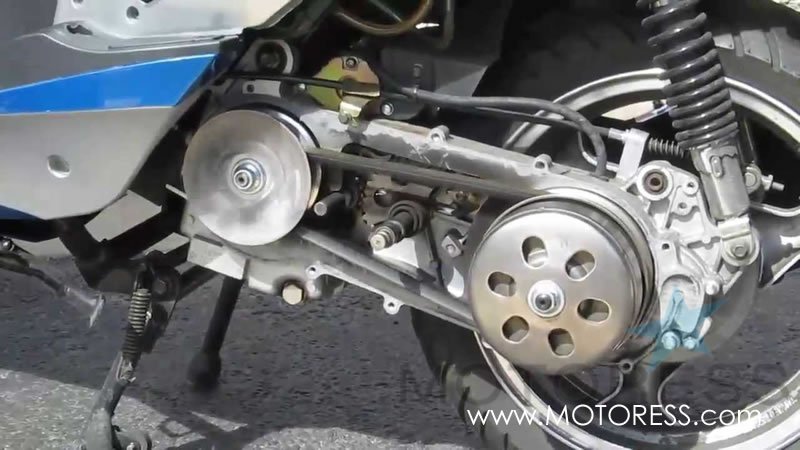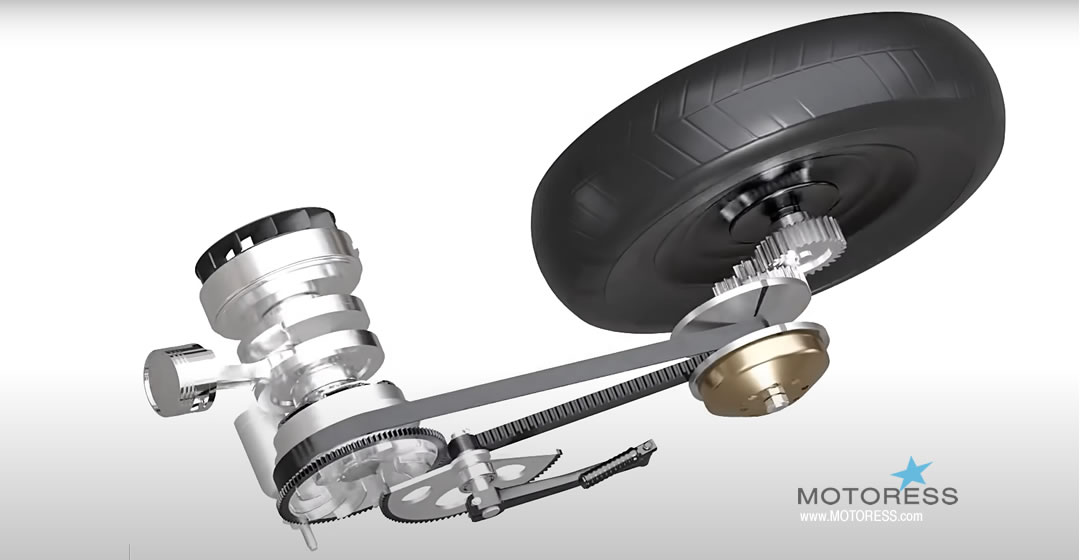Last Update: 25 October 2023

Automatic powersports vehicles utilise a technology known as the “Continuously Variable Transmission” or CVT for short to propel them, in stark contrast to the traditional manual shifting transmissions found in nearly all motorcycles. CVTs are the key feature that makes powersports vehicles, like motor-scooters, entirely automatic and incredibly enjoyable to operate. These versatile CVTs find application not only in powersports but also in various other domains, including automobiles, tractors, earthmoving equipment, and a range of powersports vehicles, such as scooters, snowmobiles, and the Can-Am Spyder, amongst others.
With a CVT transmission there’s no clutch and no shifting gears as is the case in the common motorcycle. They’re fully automatic. You simply just – “twist and go!” And today, you can find very powerful high-torque and highly powered CVT engines in all these forms of powersports vehicles meaning as in the case of the scooter, it’s easy to ride highway and long distance
The CVT transmission eliminates the need for a clutch and the manual process of shifting gears, a notable departure from the conventional motorcycle experience. With CVT, everything is fully automatic, allowing riders to simply “twist and go!” Moreover, modern CVT engines in powersports vehicles are impressively robust, delivering high torque and substantial power. This high-performance capability extends to scooters, making them suitable for highway cruising and long-distance journeys, rendering them both powerful and practical for extended rides.
With CVT, everything is fully automatic, allowing riders to simply “twist and go!” Moreover, modern CVT engines in powersports vehicles are impressively robust, delivering high torque and substantial power.
Step-Less Acceleration

A Continuously Variable Transmission (CVT) is an automatic transmission system capable of smoothly transitioning through an uninterrupted spectrum of gear ratios, in stark contrast to traditional transmissions, which offer a finite number of gear ratios in fixed increments. The adaptability of a CVT, when properly controlled, enables the engine to maintain a consistent RPM while the vehicle’s speed varies, offering a unique combination of power and efficiency.
For motorcycle riders transitioning to a scooter with a CVT transmission, it’s common to find that they inadvertently exceed the road’s speed limit. This phenomenon can be attributed to the “step-less acceleration” achieved by the CVT transmission, allowing for a seamless and continuous increase in speed.
CVT transmissions offer a distinctive feature where the “gear ratios” automatically adjust within the system’s limits without the constraints of predefined, specific gear ratios found in traditional motorcycle transmissions. As a result, accelerating with a CVT is an exceptionally smooth, “step-less” process. In essence, a CVT transmission possesses an extensive array of “gears” that it can seamlessly cycle through at any given moment and at any engine or vehicle speed. This inherent flexibility can lead to unexpectedly rapid acceleration, catching riders by surprise. When accelerating, the engine initially revs up to its optimal RPM (revolutions per minute) range and then maintains that level while the ratio shifts to increase wheel RPM without altering the engine RPM. This design feature results in a continuous and effortless acceleration experience.
Smooth Uninterrupted Process
Indeed, this is in stark contrast to the experience of riding a traditional motorcycle with a fixed gear transmission. On a conventional motorcycle, you rely on the engine’s speed within a specific gear to gauge your speed. Each gear is fixed and has a set relationship with others. When transitioning to a motorcycle with a CVT transmission, it can be surprising to find that the vehicle’s speed keeps rising even as the engine RPMs stay consistent. This unique characteristic can make it challenging to notice the increase in acceleration. In fact, it might serve as a handy explanation if you happen to be pulled over by the police for unintentionally exceeding the speed limit!

The core mechanism at work in this system involves a belt positioned between two pulleys. What makes it interesting is that the effective radii of these pulleys can change based on the scooter’s speed. As one radius expands, the other contracts, all while maintaining a constant belt length. Over time, these belts tend to stretch, and as they do, they can slip and lose their ability to transmit power to the wheel. Replacing these belts is a routine maintenance procedure for motorcycles equipped with CVT systems.
Outstanding Fuel Efficiency
In addition to the typical lighter weight of scooters, the CVT transmission is a key factor contributing to significantly improved fuel economy compared to traditional motorcycle transmissions. The CVT allows the engine to operate at its optimal RPM for a variety of vehicle speeds. This efficiency is achieved by maintaining a consistent angular velocity of the drive shaft across a wide range of output speeds.
A Continuously Variable Transmission (CVT) is just that: there’s a continuous range of gear ratios as opposed to a conventional automatic which has a fixed number of gears.
The simplicity and step-less nature of the CVT transmission make them the perfect transmission for a variety of machines and devices-not only scooters. CVTs have a rich history of application in power tools and drill presses, as well as in tractors and snowmobiles.

There’s one challenge the CVT presents versus the standard manual motorcycle transmission. If you’ve got a dead battery you won’t be able to “bump start” your CVT driven motorcycle. Even though scooters are often equipped with a kick-starter along with its electric ignition, it still won’t help in the case of a truly dead battery. An additional reason to pay extra attention to your battery’s maintenance.
The Single Drawback
However, there’s one drawback to the CVT when compared to the conventional manual motorcycle transmission. In the event of a dead battery, you won’t have the option to “bump start” your CVT-equipped motorcycle. Even though many scooters are equipped with a kick-starter in addition to electric ignition, it might come to your aid when dealing with a completely drained battery. This serves as an additional incentive to ensure diligent maintenance of your battery.





1 comment
The best CVT transmission for scooter that I tried on my 14 year as a mechanic is the JCosta. This variators changed my way to give more performance to scooters clients. Have a look the website: https://jcosta.com